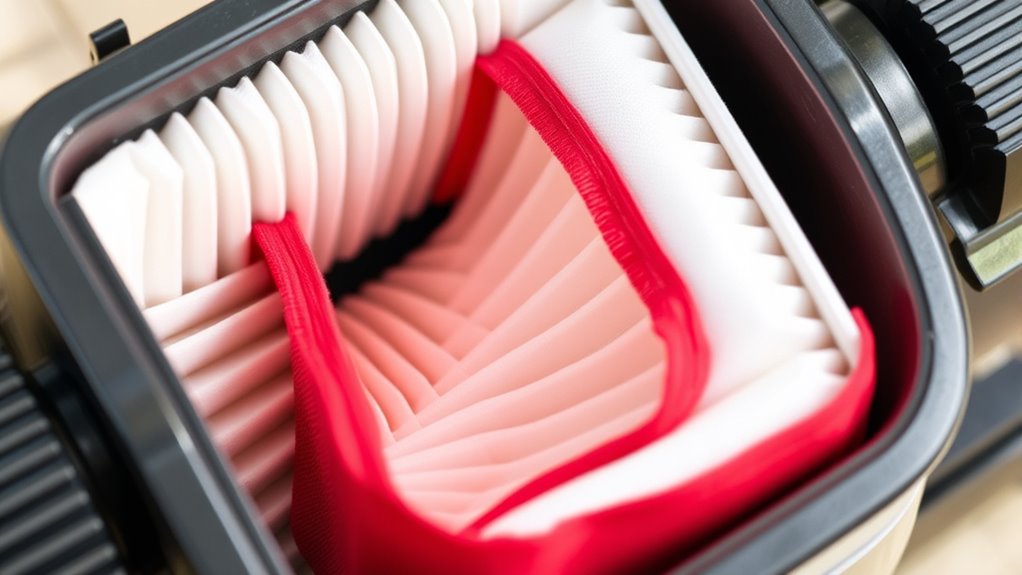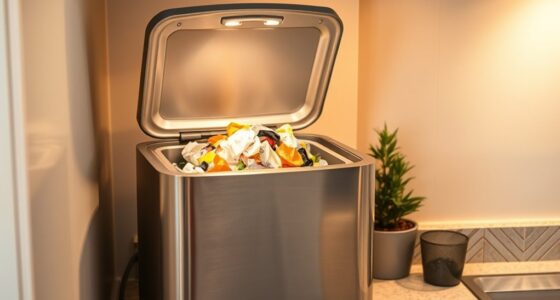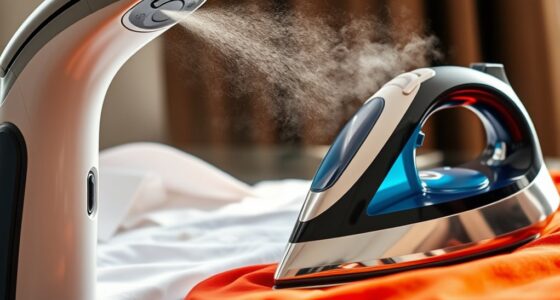To keep your vacuum performing well, replace bags when they’re about 75% full and switch out filters every three to six months, depending on use. Regular maintenance prevents loss of suction, improves air quality, and extends the life of your vacuum. Look out for signs like reduced power or odors. Staying on schedule for replacements is key—continue here, and you’ll discover easy tips to stay ahead of dirty filters and bags.
Key Takeaways
- Replace vacuum bags when they are about 75% full to maintain suction and airflow.
- Change filters every 3 to 6 months, depending on usage and manufacturer recommendations.
- Watch for signs like decreased suction, strange odors, or visible dirt buildup indicating it’s time for replacement.
- Regularly inspect and clean filters, replacing them if heavily soiled or damaged for optimal performance.
- Use genuine parts and set calendar reminders to ensure consistent maintenance intervals.

Vacuum filters and bags play a crucial role in maintaining your vacuum cleaner’s performance and guaranteeing clean indoor air. When these components are in good shape, your vacuum works efficiently, capturing dirt, dust, and allergens without issue. Conversely, neglecting to replace or clean them can lead to decreased suction power, poorer air quality, and even damage to your vacuum. That’s why understanding the importance of timely replacements is essential for keeping your home clean and your vacuum running smoothly.
Over time, vacuum bags and filters accumulate dirt, debris, pet hair, and dust, which reduces their ability to trap particles effectively. When a bag becomes full or a filter is clogged, airflow is restricted. This not only hampers cleaning efficiency but also forces your vacuum motor to work harder, increasing wear and tear. You might notice your vacuum struggling to pick up debris or emitting a musty odor—both signs it’s time for a change. Regularly checking and replacing these parts prevents such issues and prolongs your vacuum’s lifespan.
Dirty filters and full bags reduce suction and can damage your vacuum. Regular replacement keeps it running smoothly.
Replacing vacuum bags and filters on a consistent schedule might seem tedious, but it’s a simple task that pays off. Many manufacturers recommend changing bags once they’re about 75% full, or roughly after every few uses, especially if you have pets or allergies. Filters, depending on their type, should be cleaned or replaced more frequently—generally every three to six months. Using high-quality bags and filters suited to your vacuum model ensures excellent performance, so always refer to your user manual for specific guidelines.
You don’t need to wait until your vacuum’s performance drops noticeably before replacing bags and filters. Instead, adopt a proactive approach. Mark your calendar or set reminders to check these components regularly. This habit prevents the buildup of dirt and allergens, helping you maintain a healthier indoor environment. It’s also worth investing in genuine replacement parts, as they’re designed to fit perfectly and work effectively with your vacuum, unlike cheaper generic alternatives that may compromise performance.
In addition to regular replacements, keep an eye on the condition of your filters. Many can be cleaned with water or a gentle brush, which can extend their life. However, if they’re heavily soiled or damaged, replacing them is the best course of action. Clean filters help maintain airflow and filtration efficiency, ensuring your vacuum continues to trap allergens and fine dust particles. Regular maintenance of these components can also prevent performance issues and ensure your vacuum operates at optimal levels.
Frequently Asked Questions
How Do I Dispose of Used Vacuum Filters Safely?
You should dispose of used vacuum filters safely by first checking if they’re recyclable, then sealing them in a plastic bag to prevent dust escape. Place the bag in your regular trash, but avoid composting or burning them, as filters may contain harmful particles or chemicals. Always wash your hands afterward and follow local disposal regulations to guarantee eco-friendly and safe disposal.
Can I Wash and Reuse Disposable Vacuum Bags?
Can you wash and reuse disposable vacuum bags? Generally, no. Disposable bags are designed for single use, and attempting to wash them can damage the bag and release dust or dirt back into your environment. Isn’t it better to replace them regularly for ideal cleaning and air quality? Instead, opt for reusable bags if you want an eco-friendly option, but always follow the manufacturer’s instructions for proper maintenance.
Are There Eco-Friendly Vacuum Filter Options Available?
Yes, eco-friendly vacuum filter options are available. You can choose reusable filters made from sustainable materials like washable HEPA filters, which you can clean and reuse multiple times. Some brands offer biodegradable or plant-based filters that break down naturally, reducing waste. Look for products labeled as environmentally friendly or sustainable. By opting for these, you help lower your ecological footprint while maintaining effective vacuum performance.
How Often Should I Check for Mold or Bacteria in Filters?
You should check your filters for mold and bacteria every time you use your vacuum—yes, every single session! These tiny enemies thrive in damp, dirty environments and can turn your home into a health hazard faster than you blink. Regular inspections, at least once a month, help catch mold and bacteria early, keeping your air clean and your family safe. Don’t wait for symptoms—be proactive and protect your space.
Do Different Floor Types Require Specific Vacuum Filter Types?
Yes, different floor types require specific vacuum filter types. For carpets, you need filters that trap fine dust and allergens effectively, like HEPA filters. Hard floors, on the other hand, benefit from filters that prevent debris from scattering. Check your vacuum’s manual for recommendations, and always choose filters designed for your floor type to guarantee ideal cleaning, airflow, and filter longevity.
Conclusion
Replacing your vacuum filters and bags on the right rhythm keeps your cleaner working efficiently. Imagine noticing your vacuum losing power during your weekly clean—then you realize it’s time for a replacement. By sticking to a regular schedule, like every three months, you prevent buildup and maintain strong suction. Just like Sarah, who changed her filters regularly and kept her home spotless effortlessly, you’ll enjoy cleaner air and a longer-lasting vacuum with minimal effort.









